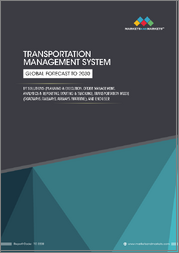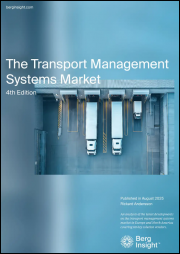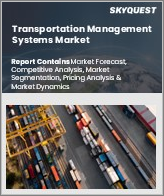
|
시장보고서
상품코드
1628952
운송 관리 시스템 시장 규모, 점유율, 성장 분석 : 구성요소별, 전개 방식별, 조직 규모별, 운송 수단별, 최종 이용 산업별, 지역별 - 산업 예측(2025-2032년)Transport Management System Market Size, Share, Growth Analysis, By Component, By Deployment Type, By Organization Size, By Transportation Mode, By End-User Industry, By Region - Industry Forecast 2025-2032 |
||||||
운송 관리 시스템 세계 시장 규모는 2023년 114억 5,000만 달러로 2024년 126억 3,000만 달러에서 2032년 276억 7,000만 달러로 성장할 것으로 예상되며, 예측 기간(2025-2032년) 동안 10.3%의 CAGR로 성장할 것으로 예상됩니다.
세계 운송 관리 시스템(TMS) 시장은 지속가능한 공급망 관리에 대한 수요, 세계화의 진전, 운송 업무의 실시간 가시성 확보의 필요성 등을 배경으로 호황을 누리고 있습니다. 제조업, 소매업, 물류업 등의 산업에서 TMS 솔루션의 채택이 두드러지게 나타나고 있습니다. 주요 트렌드에는 인공지능, 머신러닝, 사물인터넷(IoT) 등 첨단 기술의 통합이 포함되며, 이는 경로 최적화, 예측 분석, 전반적인 업무 효율을 향상시킵니다. 클라우드 기반 TMS 솔루션은 확장성, 유연성, 비용 효율성으로 인해 인기가 높아지고 있습니다. 또한, 지속가능성과 환경 문제에 대한 인식이 높아지면서 기업들이 녹색 물류를 우선시하고 운송 관리 전략에 친환경적인 관행을 도입하여 시장 성장을 더욱 촉진하고 있습니다.
목차
소개
- 조사 목적
- 조사 범위
- 정의
조사 방법
- 정보 조달
- 2차 데이터와 1차 데이터 방법
- 시장 규모 예측
- 시장 가정과 제한
주요 요약
- 세계 시장 전망
- 공급과 수요 동향 분석
- 부문별 기회 분석
시장 역학과 전망
- 시장 개요
- 시장 규모
- 시장 역학
- 성장 촉진요인과 기회
- 성장 억제요인과 과제
- Porters 분석
주요 시장 인사이트
- 핵심성공요인
- 경쟁 정도
- 주요 투자 기회
- 시장 생태계
- 시장 매력 지수(2024년)
- PESTEL 분석
- 거시경제 지표
- 밸류체인 분석
- 가격 분석
- 사례 연구
- 기술의 진보
- 규제 상황
- 특허 분석
운송 관리 시스템 시장 규모 : 구성요소별
- 시장 개요
- 소프트웨어
- 계획과 실행
- 주문 관리
- 감사 지불 청구
- 보고와 분석
- 라우팅과 추적
- 서비스
- 컨설팅
- 구현
- 지원과 유지관리
운송 관리 시스템 시장 규모 : 전개 방식별
- 시장 개요
- 온프레미스
- 클라우드 기반
운송 관리 시스템 시장 규모 : 조직 규모별
- 시장 개요
- 중소기업
- 대기업
운송 관리 시스템 시장 규모 : 교통 수단별
- 시장 개요
- 도로
- 철도
- 항공
- 해운
운송 관리 시스템 시장 규모 : 최종 이용 업계별
- 시장 개요
- 소매
- 제조업
- 물류·운송
- 헬스케어와 의약품
- 정부
- 에너지와 유틸리티
- 기타
운송 관리 시스템 시장 규모
- 북미
- 미국
- 캐나다
- 유럽
- 독일
- 스페인
- 프랑스
- 영국
- 이탈리아
- 기타 유럽
- 아시아태평양
- 중국
- 인도
- 일본
- 한국
- 기타 아시아태평양
- 라틴아메리카
- 브라질
- 기타 라틴아메리카
- 중동 및 아프리카
- GCC 국가
- 남아프리카공화국
- 기타 중동 및 아프리카
경쟁 정보
- 상위 5개사의 비교
- 주요 기업의 시장 포지셔닝(2024년)
- 주요 시장 기업이 채용한 전략
- 시장의 최근 동향
- 기업의 시장 점유율 분석(2024년)
- 주요 기업 개요
- 기업 개요
- 제품 포트폴리오 분석
- 부문별 점유율 분석
- 매출 전년비 비교(2022-2024)
주요 기업 개요
- SAP SE(Germany)
- Oracle Corporation(USA)
- Manhattan Associates Inc.(USA)
- The Descartes Systems Group Inc.(Canada)
- MercuryGate International Inc.(USA)
- Trimble Inc.(USA)
- Infor(USA)
- JDA Software Group, Inc.(USA)
- Kuebix(USA)
- Transplace(USA)
- E2open(USA)
- FourKites Inc.(USA)
- Samsara Inc.(USA)
- 3Gtms, Inc.(USA)
- Shipwell(USA)
- Blume Global(USA)
- FreightWise LLC(USA)
결론과 추천사항
ksm 25.02.06Global Transport Management System Market size was valued at USD 11.45 billion in 2023 and is poised to grow from USD 12.63 billion in 2024 to USD 27.67 billion by 2032, growing at a CAGR of 10.3% during the forecast period (2025-2032).
The global Transport Management System (TMS) market is thriving, driven by the demand for sustainable supply chain management, increasing globalization, and the necessity for real-time visibility in transportation operations. Industries such as manufacturing, retail, and logistics are prominently adopting TMS solutions. Key trends include the integration of advanced technologies like artificial intelligence, machine learning, and the Internet of Things (IoT), which enhance route optimization, predictive analytics, and overall operational efficiency. Cloud-based TMS solutions are becoming increasingly popular due to their scalability, flexibility, and cost-effectiveness. Moreover, heightened awareness of sustainability and environmental concerns is prompting businesses to prioritize green logistics, incorporating eco-friendly practices into their transportation management strategies, thus further fueling market growth.
Top-down and bottom-up approaches were used to estimate and validate the size of the Global Transport Management System market and to estimate the size of various other dependent submarkets. The research methodology used to estimate the market size includes the following details: The key players in the market were identified through secondary research, and their market shares in the respective regions were determined through primary and secondary research. This entire procedure includes the study of the annual and financial reports of the top market players and extensive interviews for key insights from industry leaders such as CEOs, VPs, directors, and marketing executives. All percentage shares split, and breakdowns were determined using secondary sources and verified through Primary sources. All possible parameters that affect the markets covered in this research study have been accounted for, viewed in extensive detail, verified through primary research, and analyzed to get the final quantitative and qualitative data.
Global Transport Management System Market Segmental Analysis
Global Transport Management System Market is segmented by Component, Deployment Type, Organization Size, Transportation Mode, End-User Industry and region. Based on Component, the market is segmented into Software and Services. Based on Deployment Type, the market is segmented into On-Premises and Cloud-Based. Based on Organization Size, the market is segmented into Small and Medium-Sized Enterprises (SMEs) and Large Enterprises. Based on Transportation Mode, the market is segmented into Roadways, Railways, Airways and Maritime. Based on End-User Industry, the market is segmented into Retail, Manufacturing, Logistics and Transportation, Healthcare and Pharmaceuticals, Government, Energy and Utilities and Others. Based on region, the market is segmented into North America, Europe, Asia Pacific, Latin America and Middle East & Africa.
Driver of the Global Transport Management System Market
The Global Transport Management System market is significantly influenced by the growing intricacy of supply chains within today's interconnected global economy. As businesses strive to enhance operational efficiency, there is a pressing need for effective logistics solutions that streamline transportation processes. This complexity arises from factors such as diverse markets, varied regulatory requirements, and the demand for quicker delivery timelines. Consequently, organizations are increasingly reliant on advanced transport management systems to optimize their logistics operations, improve resource allocation, and reduce costs, all while ensuring timely and efficient delivery of goods. This drive for efficient logistics is a key driver of market growth.
Restraints in the Global Transport Management System Market
One significant restraint in the Global Transport Management System market is the integration of advanced technologies, such as artificial intelligence and the Internet of Things (IoT). The implementation of these sophisticated systems often requires substantial upfront investments that can be a barrier for smaller enterprises. These businesses may find it challenging to allocate the necessary financial resources, which can prevent them from adopting the latest technologies essential for optimizing their transport management processes. Consequently, the high costs associated with advanced technology may limit market growth and encourage a reliance on traditional systems among smaller players in the industry.
Market Trends of the Global Transport Management System Market
The Global Transport Management System market is witnessing a significant trend toward the integration of advanced technologies, including artificial intelligence, machine learning, and the Internet of Things (IoT). These innovations are fundamentally enhancing route optimization, predictive analytics, and overall operational efficiency. Additionally, the shift to cloud-based solutions is gaining momentum, providing businesses with crucial scalability, flexibility, and cost-effectiveness. The demand for real-time visibility and tracking has intensified, stemming from the need for transparency in supply chain operations. Collectively, these trends not only streamline logistics but also empower companies to respond swiftly to market demands, driving growth in the transport management sector.
Table of Contents
Introduction
- Objectives of the Study
- Scope of the Report
- Definitions
Research Methodology
- Information Procurement
- Secondary & Primary Data Methods
- Market Size Estimation
- Market Assumptions & Limitations
Executive Summary
- Global Market Outlook
- Supply & Demand Trend Analysis
- Segmental Opportunity Analysis
Market Dynamics & Outlook
- Market Overview
- Market Size
- Market Dynamics
- Drivers & Opportunities
- Restraints & Challenges
- Porters Analysis
- Competitive rivalry
- Threat of substitute
- Bargaining power of buyers
- Threat of new entrants
- Bargaining power of suppliers
Key Market Insights
- Key Success Factors
- Degree of Competition
- Top Investment Pockets
- Market Ecosystem
- Market Attractiveness Index, 2024
- PESTEL Analysis
- Macro-Economic Indicators
- Value Chain Analysis
- Pricing Analysis
- Case Studies
- Technology Advancement
- Regulatory Landscape
- Patent Analysis
Global Transport Management System Market Size by Component & CAGR (2025-2032)
- Market Overview
- Software
- Planning and Execution
- Order Management
- Audit, Payment, and Claims
- Reporting and Analytics
- Routing and Tracking
- Services
- Consulting
- Implementation
- Support and Maintenance
Global Transport Management System Market Size by Deployment Type & CAGR (2025-2032)
- Market Overview
- On-Premises
- Cloud-Based
Global Transport Management System Market Size by Organization Size & CAGR (2025-2032)
- Market Overview
- Small and Medium-Sized Enterprises (SMEs)
- Large Enterprises
Global Transport Management System Market Size by Transportation Mode & CAGR (2025-2032)
- Market Overview
- Roadways
- Railways
- Airways
- Maritime
Global Transport Management System Market Size by End-User Industry & CAGR (2025-2032)
- Market Overview
- Retail
- Manufacturing
- Logistics and Transportation
- Healthcare and Pharmaceuticals
- Government
- Energy and Utilities
- Others
Global Transport Management System Market Size & CAGR (2025-2032)
- North America (Component, Deployment Type, Organization Size, Transportation Mode, End-User Industry)
- US
- Canada
- Europe (Component, Deployment Type, Organization Size, Transportation Mode, End-User Industry)
- Germany
- Spain
- France
- UK
- Italy
- Rest of Europe
- Asia Pacific (Component, Deployment Type, Organization Size, Transportation Mode, End-User Industry)
- China
- India
- Japan
- South Korea
- Rest of Asia-Pacific
- Latin America (Component, Deployment Type, Organization Size, Transportation Mode, End-User Industry)
- Brazil
- Rest of Latin America
- Middle East & Africa (Component, Deployment Type, Organization Size, Transportation Mode, End-User Industry)
- GCC Countries
- South Africa
- Rest of Middle East & Africa
Competitive Intelligence
- Top 5 Player Comparison
- Market Positioning of Key Players, 2024
- Strategies Adopted by Key Market Players
- Recent Developments in the Market
- Company Market Share Analysis, 2024
- Company Profiles of All Key Players
- Company Details
- Product Portfolio Analysis
- Company's Segmental Share Analysis
- Revenue Y-O-Y Comparison (2022-2024)
Key Company Profiles
- SAP SE (Germany)
- Company Overview
- Business Segment Overview
- Financial Updates
- Key Developments
- Oracle Corporation (USA)
- Company Overview
- Business Segment Overview
- Financial Updates
- Key Developments
- Manhattan Associates Inc. (USA)
- Company Overview
- Business Segment Overview
- Financial Updates
- Key Developments
- The Descartes Systems Group Inc. (Canada)
- Company Overview
- Business Segment Overview
- Financial Updates
- Key Developments
- MercuryGate International Inc. (USA)
- Company Overview
- Business Segment Overview
- Financial Updates
- Key Developments
- Trimble Inc. (USA)
- Company Overview
- Business Segment Overview
- Financial Updates
- Key Developments
- Infor (USA)
- Company Overview
- Business Segment Overview
- Financial Updates
- Key Developments
- JDA Software Group, Inc. (USA)
- Company Overview
- Business Segment Overview
- Financial Updates
- Key Developments
- Kuebix (USA)
- Company Overview
- Business Segment Overview
- Financial Updates
- Key Developments
- Transplace (USA)
- Company Overview
- Business Segment Overview
- Financial Updates
- Key Developments
- E2open (USA)
- Company Overview
- Business Segment Overview
- Financial Updates
- Key Developments
- FourKites Inc. (USA)
- Company Overview
- Business Segment Overview
- Financial Updates
- Key Developments
- Samsara Inc. (USA)
- Company Overview
- Business Segment Overview
- Financial Updates
- Key Developments
- 3Gtms, Inc. (USA)
- Company Overview
- Business Segment Overview
- Financial Updates
- Key Developments
- Shipwell (USA)
- Company Overview
- Business Segment Overview
- Financial Updates
- Key Developments
- Blume Global (USA)
- Company Overview
- Business Segment Overview
- Financial Updates
- Key Developments
- FreightWise LLC (USA)
- Company Overview
- Business Segment Overview
- Financial Updates
- Key Developments



















